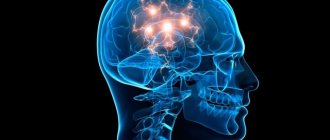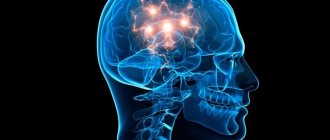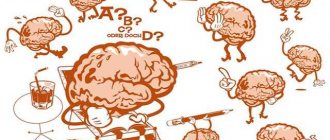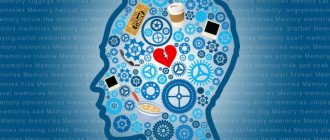Physiological basis
The physiological basis will be traces of nervous shocks experienced in the past, preserved in the cerebral cortex due to the plasticity of the central nervous system: any process provoked by an external factor cannot pass through the nervous tissue without a trace, but leaves an “imprint” inside it as certain functional changes .
They make it easier for accompanying processes in the central nervous system to occur when they are repeated. The physiological processes in the brain observed during the process of memory are the same in content as during perception: memory requires the functioning of the same central nervous system apparatuses as perception itself. It is caused by the influence of external factors.
The fact that emotions exist was proven by scientists when the amygdala was opened in the temporal part of the brain. This part of the limbic system is directly responsible for the formation of emotions. However, autonomic changes within the body under the influence of anxiety, for example, are a function of the hypothalamus. The processes that occur in the limbic system are characterized by electrical and biochemical origin. They affect the well-being of internal organs.
- How are works of art created? The role of emotional memory
- General information
- Reasons for sudden mood changes
- Types of memory: what we remember
- Research on emotional memory
- Mechanisms of action
- Exercises for children
- Physiology of the memory process
- How are works of art created? The role of emotional memory
- Classification by types and methods of memorization
The only difference is that during perception the central processes are constantly supported by irritation of the receptors, and during memory they are only “imprints” of the nervous processes that have occurred.
All emotions remain in memory due to the development of synaptic connections. Different areas of the brain are involved in the formation of the trace:
- cortex: crown, temporal and frontal regions;
- cerebellum;
- hippocampus;
- subcortical nodes.
The relationship between neurons will be established over time
The functioning of the chemical components (endorphin, calcium and enkephalin) is important here. These components are hormones that transmit impulses
Main types of memory
In psychology, memory refers to a number of abilities that record the experience gained, keep it in an active state, for reproduction in the future. The process involves the mechanisms of memorization, preservation, reproduction and forgetting.
The development of memory affects the development of the child’s personality.
Information comes to the preschooler through the senses:
- visual - memorizing visible images;
- auditory - everything that the preschooler perceived through the organs of hearing;
- gustatory - memories of the taste of foods eaten;
- olfactory - remembering different aromas;
- tactile - sensations that were received during contact with an object.
Important! Each of the above types must be developed separately, by using the corresponding senses. Based on duration, children's memory is divided into 2 types:
Based on duration, children's memory is divided into 2 types:
- Short-term. Information stays in the brain for a short period and disappears after a while. May only last 20-30 seconds.
- Long-term. The experience gained is retained for a long time. It can be mechanical or semantic.
The memory of a preschooler can be either involuntary (information is stored on its own) or voluntary (in order to remember something, you need to make an effort).
Types of memory
What memory predominates in preschool age
Each stage of memory development in preschool age has its own characteristics:
- Children from 0 to one year old develop motor memory quickly. Manifests itself in the form of conditioned reflexes. During this period, the baby observes the actions of his parents and tries to repeat them. Memorization will be effective if learning is accompanied by vivid emotions.
- From one to two years, the Central Unequal System develops. At this age, figurative memorization predominates. The baby recognizes the face of mom and dad and takes his first steps.
- At the age of 2-4 years, the rapid development of mechanical memory in children occurs. The child begins to remember words and think logically.
- In preschoolers aged 4-6 years, involuntary memorization is in the lead. They usually absorb information that seems interesting to them.
Over time, children’s memory mechanisms become stronger and the quality of their thinking improves. Children become more capable of learning.
Specific features of memorization in preschool age
Mechanical memory
Preschoolers have well-developed mechanical memory. They remember without much effort and then reproduce what they saw or heard. The main thing is that the information arouses interest. Sometimes it is called “cramming”; the semantic part of the material fades into the background. Vocabulary quickly improves and increases.
Why is it necessary to develop the memory of preschoolers
The baby doesn’t have to know and remember everything. But, thanks to a good memory, it will be easier for him to learn and live
The development of memory in preschool children improves the functioning of such processes as: attention, thinking, imagination. The older the child gets, the better the memory processes work.
All this is due to the fact that the child improves the technique of assimilating new information.
Important! You need to train your memory at a very early age, this will give you the opportunity to apply the acquired skills and abilities in the future.
How are works of art created? The role of emotional memory
People of creative professions are good at using images. They need to be able to analyze and synthesize images, make analogies and produce new ideas. Without constant attention to these mental processes; to the accumulated emotional experience, the images will be blurry. Accordingly, the actor will not be able to reproduce them clearly enough on stage.
The ability to select a chain of similar images for each image is important. All great geniuses were able to keep in memory many such chains of emotional images, which they then embodied in music or drawing.
This can be learned. Another important characteristic of the emotional memory of a creative person is a low threshold of sensitivity. The lower the threshold of emotional sensitivity, the more information about the world and other people a creative person can perceive and embody.
General information
Emotional memory is the memory of vivid, memorable events. It plays an important role in the life of all people. Past and preserved emotions and memories become signals that encourage decisive action or deter those that caused previously negative experiences. Emotional memory is much stronger than its other varieties. In some cases, events that happened long ago leave only sensations, emotions, and impressions in memory.
Emotional memory refers to memories of previously experienced emotions and feelings. Experts to this day do not have a consensus on what is better deposited in the subconscious, positive or negative impressions. Western scientists claim that positive emotions are remembered more strongly, while Russians believe that negative emotions (suffering, anxiety) are much more important for survival.
It cannot be said that if there is no emotional memory, then this is a significant disadvantage, but in many professions, for example, teachers and art workers, it is necessary. The ability to sympathize will also become underdeveloped.
If you do not have this type of memory, you should not despair, since this is only a skill that can be improved through constant training.
For adults
1. Diary. By writing down your own feelings and emotions, and then re-reading them over time, you can regain them again. And exercise your emotional memory muscle.
2. Bibliotherapy. When you reread a book, you experience the emotions of the characters. Often, books read as a child evoke emotions that become attached to stimuli. A striking example: you were reading a book and the wind rose and the leaves rustled. Years later, with the wind and the rustle of leaves, you can remember those emotions and that book that you once read.
Develop your emotional memory and be open to new experiences!
Reasons for sudden mood changes
Emotional lability of a person’s personality arises due to many reasons that are individual in nature and can be combined with each other. Physiological reasons - sudden changes in mood in somatic, neurological and mental illnesses. In some cases, lability of emotional reactions appears as a symptom of other diseases:
- neoplasms in the brain;
- traumatic brain injuries;
- encephalopathy - organic brain damage;
- arterial hypertension or hypotension;
- asthenia;
- endocrine pathology.
Psychotraumatic situations and frequent stress are common external causes of lability. Prolonged emotional stress, anxiety, and fears contribute to the development of the disease. Persons with a cyclothymic and demonstrative temperament are at risk. Sharp changes in mood in women and adolescents are often observed due to hormonal changes. In healthy representatives of the fair sex, affective lability (sharp mood swings) is observed in the premenstrual period, which is for the most part the norm.
Types of emotional lability
Impulsive emotional lability includes a symptom of dysphoria - low mood with a feeling of hostility towards others. Patients with this type of disorder, in a fit of rage, are capable of resorting to violence, harming themselves and others. Hot temper is a central characteristic of the impulsive type.
Borderline lability is characterized by increased impressionability and heightened enthusiasm. Patients with this type of disorder have excellent imagination. They are able to become passionate about any activity or person. Sometimes such excessive enthusiasm is not beneficial. Patients are easily suggestible, change interests abruptly, and are restless.
Correction and therapy of emotional lability
The course of treatment for emotional lability is prescribed by specialists, taking into account the causes and individual manifestations of the disease. A full examination is necessary to find out the causes of the pathology. Treatment usually includes psychotherapy, psychotropic medications and general strengthening of the body. Children are treated with mild, natural-based sedatives
It is important for a doctor to confirm or refute the physiological basis of a mental disorder - the presence of neoplasms, organic brain lesions. Among psychotherapeutic techniques, the cognitive-behavioral method is used
Important: What is muscle stiffness and why does it appear?
The doctor helps the patient take control of his emotions, redirect them in the right direction, and learn relaxation. Among the medications used for sudden changes in mood are antidepressants or benzodiazepine tranquilizers: Phenazepam, Plevilox, Nozepam, Bifren, Phenibut, etc. Tablets should be used under the strict supervision of a psychotherapist and only after identifying the causes of the disease. Self-administration of medications can harm the body and worsen the situation. If lability is combined with asthenia, general strengthening therapy is prescribed. Necessary:
- allocate more time for rest;
- establish a sleep schedule;
- maintain a proper diet;
- take mild sedatives.
The listed points are what you can do yourself at home to help yourself or a loved one with emotional lability. You can include soothing herbs in your daily diet: lemon balm teas, valerian, a collection of sedative herbs. It is recommended to drink the hot infusion before bedtime. To treat lability, you should consult a psychotherapist.
Types of memory: what we remember
In our lives, we are faced with the need to remember very diverse information that comes to our brain through different channels and in different ways. Depending on what mental processes are involved, types of memory are distinguished.
Figurative memory
The largest amount of information in our memory is stored in the form of sensory images. We can say that all senses work on our memory:
- visual receptors supply visual images, including information in the form of printed text;
- auditory – sounds, including music and human speech;
- tactile – tactile sensations;
- olfactory – smells;
- gustatory – a variety of tastes.
Images in the brain begin to accumulate literally from birth. This type of memory is not only the largest storage of information, it can also be literally phenomenal in accuracy. The so-called eidetic memory is known - photographically accurate, detailed memorization of images. The most studied cases of such memorization are in the visual field. Eidetics are extremely rare and usually have some kind of mental abnormality, for example:
- autism;
- schizophrenia;
- suicidal tendencies.
Motor or motor memory
This is a very ancient type of memorization that arose at the dawn of evolution. But memory for movements still plays a huge role, and not only in sports activities. So we go to the table, take a mug, pour tea into it, write something in a notebook, talk - all these are movements, and they are impossible without motor memory. What can we say about the importance of motor skills in work or sports. Without motor memory it is impossible:
- teaching children to write;
- mastering the skills of knitting, embroidery, drawing;
- Even teaching babies to walk requires active motor memory.
Emotional memory
Memory for feelings is less visible in people's daily lives and seems less important. But that's not true. Our whole life is saturated with emotions, and without them it would lose its meaning, and its attractiveness too. Of course, vivid, emotionally charged events are remembered best. But we are able to remember not only the bitterness of resentment or the fireworks of first love, but also the tenderness of communication with our mother, the joy of meeting friends or getting an A in school.
Emotional memory has a pronounced associative nature, that is, memories are activated in the process of establishing a connection - an association with some phenomenon or event. Often, some insignificant detail is enough for us to once again experience a waterfall of feelings that we once experienced. True, feelings-memories never reach the strength and energy that was inherent in them for the first time.
Emotional memory is also important because emotionally charged information associated with strong feelings is best remembered and stored longer.
Verbal-logical memory
This type of memory is considered exclusively human. Pet lovers might argue that animals, such as dogs and cats, can also remember words well. Yes it is. But words for them are simply combinations of sounds associated with one or another visual, auditory, olfactory image. In humans, verbal-logical memory has a semantic, conscious character.
That is, we remember words and their combinations not as sound images, but as certain meanings. And a striking example of such semantic memorization can be the story of A.P. Chekhov “The Horse's Name.” In it, the person remembered the surname according to the meaning, and then for a long time remembered this “horse” surname. And she turned out to be Ovsov. That is, it was associative-semantic memorization that worked.
By the way, verbal-logical memory works better when you need to remember not individual words, but their meaningful structures - sentences combined into a text that has a more detailed meaning. Verbal-logical memory is not only the youngest type, but also requires conscious, purposeful development, that is, associated with memorization techniques and voluntary mental activity.
Reviews and comments
You can share your experience and thoughts on the topic of the article by leaving a comment below.
We also recommend reading:
- Storytelling
- The main ideas of Konstantin Stanislavsky
- Types of memory and their features
- Involuntary memorization: why unnecessary information is remembered, but necessary information flies out of the head
- Cognitive sphere of personality
- Exercises for memory development in preschoolers
- The effect of misinformation
- Two important laws of memory
- Cognitive load theory
- How to train your memory
- Mental processes: types and brief description
Key words:1Mnemonics
Research on emotional memory
Emotional memory works like a filter system. It is responsible for selecting facts that are more relevant in their meaning and storing them in memory more intensely and for a longer period of time.
This evolutionary perspective postulates that the human brain will be able to correctly remember unpleasant experiences even if they occurred multiple times.
In this sense, Garcia & Koeling already demonstrated in 1966 that emotional memory can be formed even with the help of a single presentation. In particular, knowledge such as taste aversion or fear formation can be obtained with a single test.
These experiments show the high capacity of emotional memory. This allows long-lasting memories to be formed in an extremely fast and simple way, which does not happen with "non-emotional memory".
Important Atypical antipsychotic tiapride: instructions, reviews
Other research into emotional memory has focused on analyzing the mechanisms involved in the relationship between emotion and memory.
At the brain level, it appears that the structures involved in the formation of emotional memory are the amygdala and hippocampus. However, there appear to be more factors involved.
Neuroendocrine effects of stress and memory
Research into the neuroendocrine effects of stress and their relationship to the formation of memories of stressful experiences has provided relevant data on emotional memory.
When a person is exposed to situations with high emotional content, large amounts of adrenal hormones are released. Mainly adrenaline and glucocorticoids.
Several studies have analyzed the action of these hormones and have shown that it is closely related to the interaction of emotions and memory.
In this sense, Bailyn and Shores showed in 2003 that administering an adrenal hormone known as corticosterone before completing a learning task modulates memory and increases recall.
Similarly, De Quervain showed that memory modulation varies depending on the timing and intensity with which hormones are released. Thus, glucocorticoids make people's memory easier.
Subsequently, research conducted by McCaugh in 2002 showed that these hormonal effects are produced through central noradrenergic mechanisms. That is, affecting the tonsils of the brain.
The presence of glucocorticoids in the blood causes greater stimulation of the amygdala. When the amygdala is active, it begins to be directly involved in the formation of memories.
Thus, when these hormones are introduced into the blood, memory begins to work through emotional memory mechanisms, so memory is strengthened and learning becomes stronger and consolidated.
links
- Beilin, A. W., & Shores, T. J. (2003). Glucocorticoids are necessary to enhance the acquisition of associative memory after acute stressful experiences. Hormones and Behavior, 43(1), 124-131.
- Christianson, S. A. (1992). Emotional stress and eyewitness memory: A critical review. Psychological Bulletin, 112(2), 284-309.
- De Quervain, D. J.-F., Roozendaal, B., & McGaugh, J. L. (1998). Stress and glucocorticoids impair the recovery of long-term spatial memory. Nature, 394, 787-790.
- Garcia, J. & Koelling, R. A. (1966). Consequence attitudes in avoidance learning. Psychomic Science, 4, 123-124.
- McEwen, B. S. & Sapolsky, R. M. (1995). Stress and cognitive function. Current Opinion in Neuroscience, 5, 205-216.
- McGaugh, J. L. & Roozendaal, B. (2002). The role of adrenal stress hormones in the formation of long-term memories in the brain. Current Opinion in Neuroscience, 12, 205-210.
Types of memory and their age characteristics. article
Types of memory and their age characteristics.
There are several bases for classifying the types of human memory. One of them is the division of memory according to the time of storage of the material, the other - according to the analyzer that predominates in the processes of memorizing, storing and reproducing the material.
In the first case, instantaneous, short-term, long-term and genetic memory are distinguished. In the second case, they talk about motor, visual, olfactory, tactile, emotional and other types of memory. Let's take a closer look at each of these types.
Instant memory is associated with retaining an accurate and complete picture of what has just been perceived by the senses, without any processing of the information received. It has a very short full preservation time - 0.3-1.0 s. Complete preservation of the visual picture is limited to fractions of a second, but there are people for whom this period is much longer (up to 10 minutes); they are called eidetics. They have the ability, in the literal sense of the word, to see on a blank screen a picture or an object that was previously in front of their eyes, but is no longer on display.
L.S. Vygotsky was of the opinion that in childhood, moderate eidetism is a completely natural and necessary phase in the development of memory.
Short-term memory is a way of storing information for a short period of time. The duration of retention of mnemonic traces here does not exceed several tens of seconds, on average about 20 (without repetition). In short-term memory, not a complete, but only a generalized image of what is perceived, its most essential elements, is stored. Short-term memory is characterized by such an indicator as volume. It is on average equal to 5 to 9 units of information and is determined by the number of units of information that a person is able to accurately reproduce several tens of seconds after this information has been presented to him once.
Short-term memory is associated with the so-called actual human consciousness. From instant memory, it receives only that information that is recognized, correlates with the current interests and needs of a person, and attracts his increased attention.
Random access memory is a memory designed to store information for a certain, predetermined period of time, ranging from several seconds to several days. The storage period of information in this memory is determined by the task faced by a person, and is designed only for solving this problem. After this, the information may disappear from RAM. This type of memory, in terms of the duration of information storage and its properties, occupies an intermediate position between short-term and long-term.
Long-term memory is a memory that can store information for an almost unlimited period of time. Information that has entered the storage of long-term memory can be reproduced by a person as many times as necessary without loss. Moreover, repeated playback only strengthens the traces in long-term memory. When long-term memory is used for recall, thinking and willpower are often required, so its functioning in practice is associated with these two processes.
Genetic memory can be defined as one in which information is stored in the genotype, transmitted and reproduced through inheritance. The main biological mechanism for storing information in such memory is, apparently, mutations and associated changes in gene structures. Human genetic memory is the only one that we cannot influence through training and education.
Visual memory is associated with the storage and reproduction of visual images. It is extremely important for people of any profession, especially for engineers and artists. Good visual memory is often possessed by people with eidetic perception, who are able to “see” the perceived picture in their imagination for quite a long time after it has ceased to affect the senses. In this regard, this type of memory presupposes a person’s developed ability to imagine. In particular, the process of memorizing and reproducing material is based on it: what a person can visually imagine, he, as a rule, remembers and reproduces more easily.
Auditory memory is a good memory and accurate reproduction of a variety of sounds, such as music or speech. It is necessary for philologists, people studying foreign languages, acousticians, and musicians. A special type of speech memory is verbal-logical, which is closely related to word, thought and logic. This type of memory is characterized by the fact that a person who has it can quickly and accurately remember the meaning of events, the logic of reasoning or any evidence, the meaning of the text being read. He can convey this meaning in his own words, and quite accurately.
Motor memory is the memorization and storage, and, if necessary, reproduction of complex movements with sufficient accuracy. It participates in the formation of motor, and in particular labor, sports skills. Improving human manual movements is directly related to this type of memory.
In addition to the above classifications, depending on the participation of the will, memory can be voluntary or involuntary. In the first case, they mean memorization that occurs automatically and without much effort on the part of the person, without setting himself a special mnemonic task (for memorization, recognition, preservation or reproduction). In the second case, such a task is necessarily present, and the process of memorization or reproduction itself requires volitional efforts.
Involuntary memorization is not necessarily weaker than voluntary; in many cases in life it is superior to it. Involuntarily, one remembers better material that involves interesting and complex mental work and that is of great importance to a person. It is shown that in this case, when significant work is done with the memorized material to comprehend, transform, and classify it involuntarily, it can be remembered better than voluntarily.
At the stage of memorization and at the stage of recollection, the organization of memory work is subordinated to the tasks of future activity. The bridge between involuntary and mediated memory was built by L.S. Vygotsky. He showed that the formation of voluntary memory occurs in a child with the help of the mediating function of speech in the process of interaction with adults. Voluntary memory is formed first as an external action using objects, then the action becomes internal and is subject to self-instruction, then the memory turns into mediated.
Historically, early forms of voluntary memory are connected, as shown by A.N. Leontyev, with memorizing some objects through others. For example, a person could put a pebble in his pocket, which later, when it fell into his hand, served as a reminder, i.e. used as a kind of memory aid. All this: both objects and actions are auxiliary means of memory. Memorization and recall produced with the help of these intermediaries is called indirect.
The development of mediated memorization in human history followed two paths. The first - improving memory with the help of external object intermediaries (amulets, stones, etc.) - led to the construction of monuments, the development of writing, photography, cinematography, etc. The second - which went through the inclusion of special actions (tying a “knot for memory”, notching) - led to the ability to instruct oneself in such a way when memorizing that later, when the need arises, one can accurately remember. The main tool for the development of voluntary memory was speech, because when a person masters inner speech, he can use the word as an internal signal - an intermediary.
For arbitrary logical memorization, you need to learn classification, i.e. be able to identify the nature of the relationships between objects and phenomena. It allows you to quickly form meaningful connections and, with their help, firmly remember impressions.
P.I. Zinchenko showed that the effectiveness of involuntary memory is closely related to certain practical human activities. The effectiveness of this type of memory is determined both by the way this activity is organized and by the structure of a person’s goals.
A.R. Luria believed that individual differences in memory could be of two types. On the one hand, the memory of different subjects differs in the predominance of one or another modality - visual, auditory, motor; on the other hand, the memory of different people may differ in the level of its organization.
It is known that in some people the visual type predominates, in others the auditory type predominates, and in others the motor type of memory predominates. A.R. Luria believed that individual differences in memory manifest both congenital (genotypic) characteristics and professional activities of people, which lead to the high development of visual, auditory, and sometimes taste memory. Of particular importance, however, are the differences in methods of memorization and in the level of memory organization among different individuals. As observations show, in some individuals direct, sensory (visual, auditory, motor) forms of memorization predominate, while in others, memorization is predominantly in the nature of complex coding of material, transforming it into verbal-logical schemes.
A significant contribution to the understanding of the phylogenetic development of memory was made by P.P. Blonsky. He expressed and developed the idea that the different types of memory present in an adult are also different stages of its historical development, and they, accordingly, can be considered phylogenetic stages of memory improvement. This refers to the following sequence of types of memory: motor, affective, figurative and logical. P.P. Blonsky expressed and substantiated the idea that in the history of human development these types of memory consistently appeared one after another.
In ontogenesis, all types of memory are formed in a child quite early and in a certain sequence. Early childhood is characterized by a predominance of mechanical memory. Over time, mechanical memory is gradually supplemented and replaced by logical memory. It is already present in a 3-4 year old child in relatively elementary forms, but reaches a normal level of development only in adolescence. Its improvement and further improvement are associated with teaching a person the basic sciences. The beginning of the development of figurative memory is associated with the second year of life, and it is believed that this type of memory reaches its highest point only in adolescence. As memory develops, it becomes closer and closer to thinking. “The analysis shows,” wrote L.S. Vygotsky, “that a child’s thinking is largely determined by his memory... Thinking for a young child means remembering.”
Initially, memory is involuntary. At preschool age, children usually do not set themselves the task of remembering anything. The development of voluntary memory in preschool age occurs in games and in the process of education. The manifestation of memorization is related to the interests of the child. Children remember better what interests them.
Rapid development of memory characteristics occurs during school years. This is due to the learning process. The process of assimilation of new knowledge predetermines the development, first of all, of voluntary memory. Unlike a preschooler, a schoolchild is forced to remember and reproduce not what is interesting to him, but what the school curriculum provides. Under the influence of the school curriculum, memorization and reproduction become increasingly arbitrary.
A special study of direct and indirect memorization in childhood was carried out by A.N. Leontyev. He experimentally showed how one mnemonic process - direct memorization - is gradually replaced with age by another, indirect one. This occurs due to the child’s assimilation of more advanced stimuli-means of memorizing and reproducing material. The role of mnemonic means in improving memory, according to A.N. Leontyev, is that by turning to the use of auxiliary means, the structure of the act of memorization thereby changes; direct, immediate memorization becomes indirect.
Based on experiments conducted with children of different ages and with students as subjects, A.N. Leontyev derived the development curve of direct and indirect memorization. This curve, called the “parallelogram of memory development,” shows that in preschoolers, direct memorization improves with age, and its development is faster than the development of indirect memorization. In parallel with this, the gap in the productivity of these types of memorization in favor of the first is increasing.
Starting from school age, there is a process of simultaneous development of direct and indirect memorization, and then more rapid improvement of indirect memory. Both curves show a tendency to converge with age, since indirect memorization, developing at a faster pace, soon catches up with direct memorization in productivity. A.A. Smirnov conducted a comparative study of memory in children of primary school age and came to the following conclusions:
— from 6 to 14 years of age, children actively develop mechanical memory for logically unrelated units of information;
— the older a primary school student gets, the less advantage he has in memorizing meaningful material over meaningless material.
The author believes that this is due to the fact that memory exercise under the influence of intensive learning based on memorization leads to a simultaneous improvement of all types of child’s memory, and, above all, those that are relatively simple and not associated with complex mental work. In children of primary school age, mechanical memory, which progresses quite quickly over three to four years of study. Logical memory lags somewhat behind in its development, since in most cases, being busy with learning, work, play and communication, it makes do with mechanical memory. If children of primary school age are specially taught mnemonic techniques from the first years of school, this significantly increases the productivity of their logical memory.
Summarizing the above, it should be noted that memory is formed in a child quite early. The ability to remember and store images in their primary forms develops in an infant during the first year of life. After 3-4 months, the child acquires the ability to recognize the mother's face and voice. At 8-12 months, he identifies objects in the visual field. By the age of one and a half years, long-term memory is formed. A child of the second year of life recognizes familiar objects and people within a few weeks, and in the third year of life even after a few months. By the age of two, children have sufficiently developed working memory. The development of memory in preschool age is characterized by a gradual transition from involuntary and immediate to voluntary and indirect memorization. In children of early preschool age, involuntary, visual-emotional memory dominates. Most normally developing children of middle and older preschool age have well-developed immediate and mechanical memory.
During school years, intensive memory development continues. In younger schoolchildren, mechanical memory progresses quite quickly, while logical memory lags somewhat behind. Younger schoolchildren remember visual material better. At this age, visual-figurative memory is of primary importance.
In adolescence, logical memory actively begins to develop and soon reaches such a level that the child begins to predominantly use this type of memory, as well as voluntary and indirect memory.
So, primary school age is sensitive for the development of higher forms of voluntary memorization, therefore purposeful developmental work on mastering mnemonic activity is the most effective during this period. Its important condition is to take into account the individual characteristics of the child’s memory, its volume, modality (visual, auditory, motor).
Mechanisms of action
According to Blonsky, the initially experienced emotion is brighter than when it emerges from memory. Over time, the emotion becomes dull and mixed with intellectual reflections and other emotions. At the same time, when confronted with similar stimuli or associations, a person’s emotions and feelings come to life, which, during a vivid emotional experience, become what is called a painful point of human perception. In some cases, this type of experience lasts a lifetime.
Three feelings are most vividly remembered - suffering, surprise and fear.
However, there is a difference. Surprise is remembered as an impression that surprised, and such a feeling itself is not experienced again. Painful experiences and suffering are remembered as a feeling of fear.
For a long time, there have been disagreements among scientists about which type of emotions is remembered better - positive or negative? Western psychologists have proven that positive ones leave a deeper mark. Blonsky reasoned from the opposite point of view. He argued that keeping a negative feeling in the mind for a long time, even in the animal world, helps preserve the population species, which proves its great importance.
Blonsky also spoke about the phenomenon of “transfer” of experienced emotions from one stimulus to similar ones. For example, if a child was bitten by a dog as a child, then, as an adult, such a person is afraid of dogs in principle. According to Blonsky, emotional memory has a significant impact on the formation of character. If a child has experienced any type of traumatic punishment or intense fear, this can lead to the development of a fearful and distrustful personality.
In 1977, American psychologists R. Brown and J. Kulik described vivid memories of certain events or situations that provoked the occurrence of emotional shock, strong feelings, as well as the events accompanying these shocks. This phenomenon in psychology is called “mnemonic photoflash”, which translates as: “memory-insight”, “flash-memory”, “vivid memories”.
Connection with acting
Emotional memory is most in demand in the art of theater and cinema. On stage, an actor deliberately recreates emotional memories in his mind to impress the audience. K.S. Stanislavsky told his students about the need for complete immersion in past emotions and feelings, trying to relive them, while understanding the essence of this emotion, understanding why it arose and how it can be transformed. K.S. Stanislavsky taught to evoke the necessary emotions and feelings at will, so that they were not tied to specific events in the student’s life. In the acting environment, there are exercises, the essence of which is to remember a brightly emotionally colored event in life and reveal it from the point of view of the motives of actions.
Overview of species
It is common for a person to forget many facts, but information that supports his beliefs, views and hobbies is stored in the storage of brain structures for a long time. Selective memorization is manifested in the fact that only part of the perceived information remains in the head. From the huge flow of information, the brain automatically saves only the facts that are currently of interest to the individual.
Interval memorization involves the gradual fixation of some data in memory and repetition of them after a certain period of time. For example, important information is recorded on a piece of paper and they try to reproduce it in memory after 2 weeks. Then the forgotten facts are written down. After half a month, all information is restored in memory. If some information could not be remembered, then it is rewritten, repeated and left for 2 weeks. And this continues until the entire text is mastered. The method of spaced repetition is used in the study of foreign languages.
Sometimes people resort to cramming in order to retain a large amount of information in their heads. The basis of mechanical fixation of material is associations by contiguity without awareness of the logical connection between fragments of the information received. This type of deliberate memorization is characterized by memorization without reflection, so it is ineffective. In contrast, semantic memorization is based on a clear understanding of the logical chains between individual fragments of the information being mastered, so it is remembered better.
Conscious
Purposeful retention of events and facts in the head is a special and complex thought process, subordinate to the task of remembering. Meaningful consolidation of material using associative series, logical reasoning, and systematic repetition is referred to as voluntary memorization.
Intentional fixation of information in the structures of the brain requires volitional efforts. Usually the subject sets himself the specific task of remembering certain data. For this purpose, he uses special techniques and performs certain actions. For example, repeated repetition of necessary data occurs until it is completely assimilated.
Unconscious
Recording information can occur accidentally, without the individual expending any volitional effort. This automatic action of the mental process is called involuntary memorization. The unintentional imprinting of some data leaves a certain trace in the cerebral cortex. Vital information is stored best in memory. Information related to the interests and needs of the subject is well remembered.
Exercises for children
This type of memory, such as emotional, must be developed from childhood, for which there are special exercises. In childhood, there is an opportunity to build a maximum of positive memories, trust in people and the world, and intellectual potential. Exercises you can do with your children:
An example of the simplest method: when you are with your child in places where he has not been before, focus his attention on the world around him: trees, views, smells, etc., accompanying this with affection, attention, hugs, so that these memories subsequently give the child strength survive negative events in your life.
- Exercise “I am happy when...”. This exercise is called a group exercise, the technique is used in kindergartens and schools. A ball is thrown to the child asking him to tell about events when he is happy. After this, his task is to perform the same actions in relation to the other.
- An exercise with negative experiences is called the “magic bag”. This technique is usually used by psychologists when a child already has traumatic memories. They find out with the child his painful experiences, grievances, fears, then these emotions are formed into something tangible, for example - pieces of paper, some objects, and put into a bag that is tightly tied. In parallel with the bag of negative emotions, you can make the same one with positive ones, taking emotions that bring joy in a playful form.
Important The latest methods of treating multiple sclerosis
These exercises will help your child increase the number of positive experiences and cope with negativity.
Strive to spend as much time as possible with your child, pay attention to the appearance of his emotional state, hide your negative emotions, because children experience the suffering of their parents more painfully than adults themselves. Walk in new places more often, go on rides, meet animals
Over time, these exercises will give the desired effect in shaping the child’s emotional background.
Parents should remember that they are responsible for most of their children's experiences.
Physiology of the memory process
The ability to retain information is not unique to humans. Animals with a developed central nervous system can also remember and reproduce data (migratory birds know routes). The volume and duration of data storage depends on the number of nerve cells involved in the process.
Information recorded in short-term memory is transferred to long-term memory through a complex biochemical process. The neurons that make up the brain work like a recording device - they remember information and store it. Data is recorded not on individual neurons, but on a neural network - a stable collection of cells.
When a person remembers information, neurons become active. The data travels along the fibers and reaches the cluster. For information seen earlier, there is a ready-made accumulation in the brain. For data that a person learned for the first time, a new neural network is formed. There are connections between networks. A disruption in the functioning of at least one of them leads to the erasure of memories.
How are works of art created? The role of emotional memory
Konstantin Sergeevich Stanislavsky created a system for teaching acting, based on the latest discoveries in the field of the subconscious and affective memory. Stanislavski's method teaches understanding of the deep organic essence of a character.
The richer and deeper the artist’s emotional memory, the deeper and more varied the source of his creative inspiration. An actor's creativity depends on the power, sharpness, and accuracy of his emotional memory.
People of creative professions are good at using images. They need to be able to analyze and synthesize images, make analogies and produce new ideas. Without constant attention to these mental processes; to the accumulated emotional experience, the images will be blurry. Accordingly, the actor will not be able to reproduce them clearly enough on stage.
The ability to select a chain of similar images for each image is important. All great geniuses were able to keep in memory many such chains of emotional images, which they then embodied in music or drawing.
This can be learned. Another important characteristic of the emotional memory of a creative person is a low threshold of sensitivity. The lower the threshold of emotional sensitivity, the more information about the world and other people a creative person can perceive and embody.











